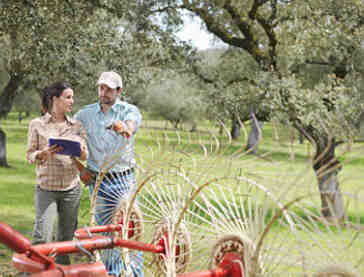
The dream of going off-grid after you lose your home just got a step further away after the rapid run-up in land values.
Even by Wall Street standards, last year’s farmland appreciation was eye-popping. The Kansas City Federal Reserve Bank said recently that land prices jumped 25 percent across the Great Plains, while the Chicago Fed reported a 22 percent increase in the heart of the corn belt.
Economists at both banks said the increase was the biggest since the 1970s. Jason Henderson, a vice president at the Kansas City Fed, said land values were driven up by two things: low interest rates and high crop prices.
Corn costs almost 90 percent more than it did three years ago, while soybeans have risen 45 percent, boosting the income that farmers expect to earn from their land. Low interest rates let them borrow cheaply to expand, while also dimming the appeal of alternative investments, such as bonds or bank CDs.
Other reports say the price of corn has about tripled in the last five years and the price of corn essentially sets the price of farming.
Even if commodity prices stay where they are, or even decline a bit, today’s land values aren’t hard to justify. “Some call it a new era,” said David Oppedahl, a business economist at the Chicago Fed. “It’s not that we will always be at today’s prices, but the thinking is that the volatility is moving around a higher average, to a higher plateau. That changes things for farmers.”
The U.S. Agriculture Department projects that corn prices will average $4.50 a bushel over the next decade, down from $6.40 now but well above the $2-to-$2.50 range that was common for much of the 1990s and early 2000s.
Pat Westhoff, co-director of the University of Missouri’s Food and Agricultural Policy Institute, also predicts that crop prices will retreat a little from the record levels of 2010 and 2011.
“I don’t think it’s enough to cause a collapse, but it should be enough to slow down the surge in farmland values that we’ve seen,” he said.
Today’s farmland boom differs from the housing bubble in a couple of important ways: It’s not fueled by debt, and farmland hasn’t yet attracted many speculators.
“Investors don’t seem to be purchasing much, because farmers have been able to outbid most of them at the auctions,” Oppedahl said. “There has been some investor interest in the sector, but it’s not a real big phenomenon.”
As for debt, both farmers and bankers seem to remember the harsh lesson of the 1980s, when overleveraged landowners lost their farms to foreclosure. Henderson says debt levels, as a percentage of farm assets, are at a record low.
“As long as farmers don’t have a lot of debt on their books, they should be able to withstand a correction in farmland values,” he added.
Not that anyone expects that correction. Certainly the supply of rich Midwestern soil isn’t getting any larger, and in fact the economists say that relatively little land changes hand each year. Meanwhile, demand for the crops grown on that land continues to grow, driven by the U.S. biofuels industry and by increased consumption in places like China.
Its bound to make some people nervous, especially older farmers who remember how property values collapsed during the farm crisis of the 1980s. Farm economists, though, don’t yet see signs of a land-price bubble.
powkey Portable Power Station 350W, 260Wh/70,000mAh Backup Lithium Battery, 110V Pure Sine Wave Power Bank with 2 AC Outlets, Portable Generator for Outdoors Camping Travel Hunting Emergency
Now retrieving the rating.
$192.98 (as of April 26, 2024 14:01 GMT +01:00 - More infoProduct prices and availability are accurate as of the date/time indicated and are subject to change. Any price and availability information displayed on [relevant Amazon Site(s), as applicable] at the time of purchase will apply to the purchase of this product.)200W Portable Power Station, Powkey 120Wh/33,000mAh Power Bank with AC Outlet, 110V 6 Outputs Solar Generator External Battery Pack with LED Light for Home Use and Outdoor Camping
Now retrieving the rating.
31% OffFoldable Solar Panel Charger 60W with 18V DC Output (11 Connectors) for 100W~350W Portable Power Stations Jackery/Rockpals/Flashfish/Enginstar, Portable Solar Generator for Outdoor Camping Van RV Trip
Now retrieving the rating.
$98.99 (as of April 26, 2024 14:01 GMT +01:00 - More infoProduct prices and availability are accurate as of the date/time indicated and are subject to change. Any price and availability information displayed on [relevant Amazon Site(s), as applicable] at the time of purchase will apply to the purchase of this product.)10W USB LED Light for Camping Garage Warehouse Car Truck Fishing Boat Outdoor Portable Bulb, Emergency Light, Children Bed Lamp
Now retrieving the rating.
$9.99 (as of April 26, 2024 14:01 GMT +01:00 - More infoProduct prices and availability are accurate as of the date/time indicated and are subject to change. Any price and availability information displayed on [relevant Amazon Site(s), as applicable] at the time of purchase will apply to the purchase of this product.)EnginStar Portable Power Station 300W 296Wh Battery Bank with 110V Pure Sine Wave AC Outlet for Outdoors Camping Hunting and Emergency, 80000mAh Backup Battery Power Supply for CPAP
Now retrieving the rating.
15% Off




